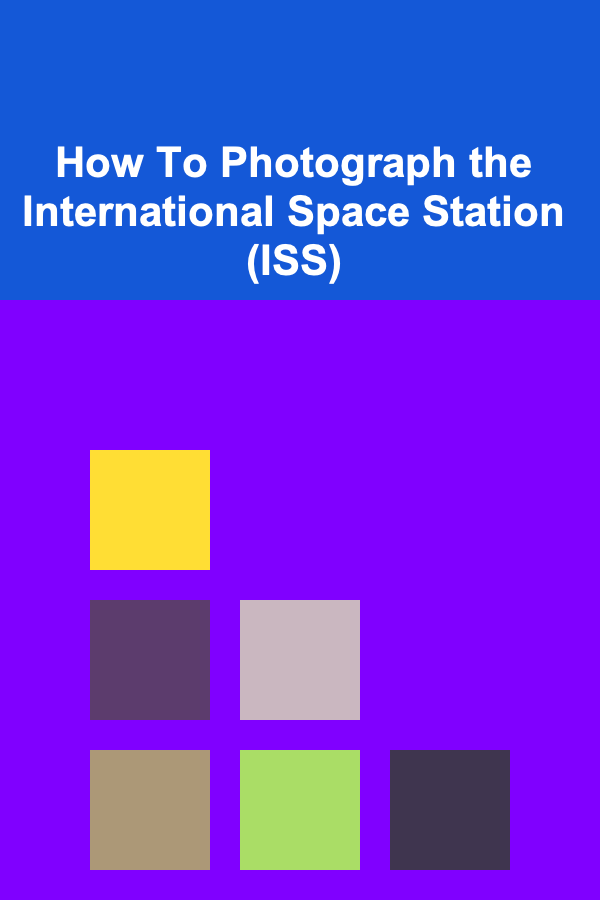
How To Photograph the International Space Station (ISS)
ebook include PDF & Audio bundle (Micro Guide)
$12.99$9.99
Limited Time Offer! Order within the next:

The International Space Station (ISS) is one of humanity's most impressive achievements. Orbiting approximately 400 kilometers above Earth, it serves as a research laboratory, a testament to global cooperation, and an awe-inspiring object in the night sky. For amateur photographers and space enthusiasts, capturing an image of the ISS can be both thrilling and challenging. In this article, we'll explore how to photograph the ISS, from understanding its orbit to technical tips and practical advice on how to get that perfect shot.
Understanding the ISS and Its Orbit
Before we dive into the technical aspects of photographing the ISS, it's essential to understand its movement and the conditions that affect its visibility. The ISS orbits the Earth at an average altitude of 400 km (about 250 miles) and travels at a speed of approximately 28,000 km/h (17,500 mph). This high speed means that it takes the station only about 90 minutes to complete one orbit around Earth, and it orbits the planet approximately 16 times a day.
The ISS is visible from Earth at certain times, depending on its orbit and the observer's location. Most of the time, the station is not visible because it is either in Earth's shadow or the Sun's rays are blocked by the horizon. However, there are specific times when it appears as a bright moving object in the sky, which is when it's best to attempt a photograph.
Key Factors to Consider for ISS Photography
- Time of Visibility: The ISS is typically visible at dawn or dusk when the Sun is below the horizon, but the station itself is still illuminated by sunlight.
- Location: The ISS will only be visible from certain locations on Earth depending on its orbit. Websites like Heavens-Above provide real-time data on when and where the ISS will be visible.
- Weather Conditions: Clear skies with minimal light pollution are crucial for getting a crisp image of the ISS. Avoid shooting when there are clouds or poor visibility.
Tools and Equipment for ISS Photography
Capturing the ISS requires the right tools, as it's not something that can easily be photographed with a casual camera. Below is a list of equipment that will help you get the best results.
1. Camera
The camera is the most important piece of equipment, and there are several options to choose from, depending on your experience level and budget.
- DSLR or Mirrorless Camera: For the best results, you should use a DSLR or mirrorless camera with manual controls. These cameras allow for better control over exposure, focus, and aperture, which are critical for astrophotography.
- Point-and-Shoot or Smartphone: If you're just starting out and don't have access to a DSLR or mirrorless camera, you can still capture the ISS with a point-and-shoot camera or smartphone. While these devices won't offer the same level of detail or flexibility, they can still capture the ISS in motion if you know when and where to point them.
2. Lens
The type of lens you choose is important, as the ISS appears as a small object in the sky, so you need a lens that can both track the station and capture detailed shots.
- Wide-Angle Lens: For capturing the ISS in the context of the surrounding sky, a wide-angle lens (such as a 14mm to 24mm) is perfect. This lens allows you to capture the ISS as it moves across the sky, showing it in relation to the stars.
- Telephoto Lens: If you want to zoom in on the ISS and capture more detail, a telephoto lens (e.g., 200mm or 400mm) will help you isolate the station from the background. You'll need a tripod and high shutter speed for these shots, as the ISS moves very quickly.
3. Tripod
A sturdy tripod is essential for astrophotography. Because the ISS moves rapidly across the sky, using a tripod allows you to keep the camera stable while you track the station's movement. You can also use a tracking mount or motorized tripod to follow the station automatically.
4. Remote Shutter Release
For precise control over your camera's shutter, a remote shutter release is a useful tool. This prevents camera shake when pressing the shutter button, which is especially important in long-exposure astrophotography.
5. Aperture and Filter
While the ISS itself is bright, using an aperture between f/4 and f/8 works well for balancing exposure. A light-pollution filter can also be useful if you're shooting from a location with a lot of artificial light.
How to Plan and Track the ISS
The key to successfully photographing the ISS is understanding when and where it will be visible. With the right tools, you can plan ahead and ensure you capture it at the optimal time.
1. Use Tracking Websites and Apps
Websites like Heavens-Above and apps like ISS Tracker provide real-time data on when the ISS will be visible from your location. They will give you exact times, directions (e.g., rising from the west), and altitude at which the ISS will be visible in the sky. This is the most reliable way to ensure you don't miss the space station's pass.
2. Know the Direction of the Pass
The ISS will always follow a particular path across the sky, typically moving from the western horizon to the eastern horizon. Understanding this direction will help you position your camera. Check the azimuth (compass direction) and altitude of the pass so you can aim your camera correctly.
3. Choose the Right Location
The best place to photograph the ISS is away from city lights, in an area with minimal light pollution. A dark, open area with a clear view of the sky will give you the best chance of capturing the station. If you live in an urban area, finding a park or nearby countryside may be beneficial.
Setting Up Your Camera
Once you know the ISS's passing time and location, it's time to set up your camera. Here are the steps for capturing the best image:
1. Position Your Camera
Mount your camera on the tripod and point it in the direction where the ISS will appear. Make sure your lens is set to manual focus, as autofocus will likely struggle in low light conditions.
2. Set the Exposure
To capture the fast-moving ISS, you'll need to adjust your camera settings to accommodate the short exposure times. Here are some general settings to start with:
- Shutter Speed: A fast shutter speed (e.g., 1/500 to 1/1000 seconds) is ideal for freezing the motion of the ISS, though it may depend on the lens you're using. The station moves quickly, so a faster shutter speed will prevent it from being blurred.
- Aperture: Set your aperture between f/4 and f/8 to ensure that enough light enters the camera, but without overexposing the image. The ISS is bright, so you don't need to open the aperture too wide.
- ISO: A low ISO setting (e.g., 800-1600) should work well. Higher ISO values will result in more noise, but the low-light environment requires sensitivity to capture the image clearly.
3. Use Continuous Shooting Mode
Set your camera to continuous shooting mode to take multiple shots in a row. This way, you can increase your chances of capturing the ISS without the need to press the shutter each time it passes.
4. Test Shots and Adjustments
Before the ISS makes its pass, take a few test shots to make sure your exposure, focus, and framing are correct. Adjust the settings based on the results, and be ready to make quick changes once the ISS begins its pass.
Capturing the ISS in Motion
As the ISS approaches, it will appear as a bright moving object across the sky. You need to track its movement and fire your camera's shutter at the right time.
1. Track the ISS
Once the ISS becomes visible, follow its movement through the sky. If you're using a telephoto lens, this will be especially tricky, as you'll need to constantly adjust the camera's position. A motorized tripod mount can make this process much easier by allowing the camera to track the ISS automatically.
2. Timing Your Shots
The key to getting the perfect shot is timing. The ISS will be in the sky for only a few minutes, so be ready to shoot as soon as it becomes visible. Keep firing as it moves across the sky, and try to get several different frames.
Post-Processing Your Images
After the shoot, you'll likely need to enhance your images with post-processing to bring out the details and make the ISS more prominent. Here are some tips for editing your photos:
- Noise Reduction: If you shot at higher ISOs, you may notice noise in your photos. Use noise reduction tools in software like Adobe Lightroom or Photoshop to minimize it.
- Increase Contrast and Clarity: Enhancing the contrast can help the ISS stand out against the dark sky, making it easier to see.
- Crop and Align: If needed, crop your image to center the ISS or remove any unnecessary elements.
Conclusion
Photographing the International Space Station is a rewarding experience that requires a combination of timing, technical skill, and a bit of luck. By understanding the ISS's orbit, using the right equipment, and planning ahead, you can capture this incredible space station as it travels across the sky. Whether you're an experienced astrophotographer or a beginner, with the right approach, you can create stunning images of one of the most iconic human-made structures in orbit.

How to Build a Checklist for Lawn Care and Maintenance
Read More
How to Clean Your Home After a Party or Family Gathering
Read More
How to Incorporate Lighting into Your Home's Architectural Features
Read More
How to Install Window Bars and Grills for Added Home Security
Read More
How to Utilize ChatGPT for Business Plan Drafting
Read More
How to Build Stronger Legs and Glutes
Read MoreOther Products

How to Build a Checklist for Lawn Care and Maintenance
Read More
How to Clean Your Home After a Party or Family Gathering
Read More
How to Incorporate Lighting into Your Home's Architectural Features
Read More
How to Install Window Bars and Grills for Added Home Security
Read More
How to Utilize ChatGPT for Business Plan Drafting
Read More